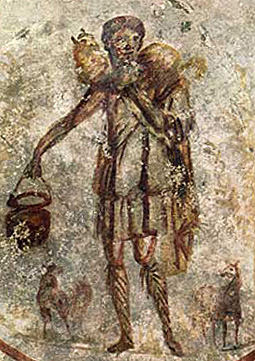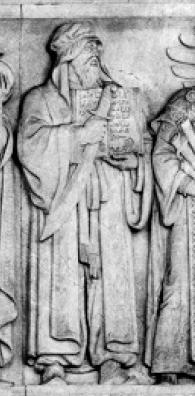





|
|
|
|
February 06, 2006
Unimaginable appearance?
In matters of idolatry (and, I suppose "graven images,") is it the image that counts, or the label assigned to the image? The concept is bothering me, and I hope my readers will forgive me if I attempt to use this blog to figure it out. Let me see if I can get this straight. No one who is alive has ever seen the prophet Muhammad, who was never known to have sat for any sort of portrait, right? In logic, except for a few details (such as the fact that the man had a large head, dark eyes and wore a beard), that means that no one is in a position to know what he looked like, and therefore no one can declare that any particular drawing either does or does not look like Muhammad. We have only an artist's depiction of a person whose appearance is totally up to the individual artist's imagination. In other words, whether a particular image of a bearded man with dark eyes dressed in 7th century attire is Muhammad depends on whether the label of "Muhammad" is affixed onto it. Even then, how are we to know that this is the Prophet Muhammad, unless the word "prophet" too, is affixed? This means, does it not, that the argument is not over a depiction, but over the fact that a given depiction has been given a certain label? How can an image of something unknown have an appearance of being anything without a label? Christians have very little idea what Jesus looked like. The stereotyped image so often seen in religious paintings and icons is little more than an image cooked up by the medieval (mostly European) Christian imagination. Earlier Roman depictions of Jesus (and Rome was where Christianity was put on the map) show him as clean-shaven, with short hair cropped in the Roman style, and wearing a Roman tunic. Korean Christians depicted him with Asian features, while African denominations (as well as certain African American churches) have portrayed a black Jesus. The complexion of Jesus's skin, how wore his hair, whether he dressed in the traditional Jewish manner, the Hellenistic Jewish style, or even the Roman style is open to dispute, because details of the historical Jesus are sketchy. Here's one of the earliest known depictions of Jesus, from the Roman Catacombs, mid Third Century A.D.  I don't think that settles the matter of how the historical Jesus looked, but in matters of idolatry, the accuracy of the depiction is irrelevant. In theory, a depiction of a clean cut man wearing a modern business suit could just as reasonably be called an image of Jesus Christ as could a medieval man with Nordic features. I don't know how many people have examined Zombietime's Mohammad image archive in detail, but I just can't stop thinking about the fact that our own government features a depiction of Muhammad -- right smack on the the United States Supreme Court building itself! Here it is -- the North Frieze:  Muhammad (that's the Prophet Muhammad himself, folks) stands on the wall of our beloved United States Supreme Court building -- holding the sword and the Koran. Not wanting to be caught with its hand in the proverbial cookie jar, our government seems to have made a deliberately sloppy effort to muddy the waters and declare that this depiction of Muhammad really does not depict Muhammad at all: http://www.supremecourtus.gov/about/north&southwalls.pdfReally? If no one knows with any certainty what Muhammad looked like, then how does the United States Supreme Court know what he didn't look like? At the risk of arguing with the Supreme Court, I feel compelled to repeat, it's not the appearance that counts; it's the label. To more fully demonstrate my point, I'll close with a couple of images. From Zombietime, here's Muhammad:  And from another site, here's, well I'll let you guess:  Give up? OK, that last one is Jesus. But if you ask me, I'd swear that the Jesus looks quite similar to the Muhammad. If I switched the labels, would anyone care? Why? * The prophet Moses, who lived many centuries before Muhammad, is also depicted. The Supreme Court website, however does not say that the sculpture "bears no resemblance to Moses."
UPDATE: j.d. at evolution asks some good questions: The central issue in all of this is, I feel, the question of who controls the meaning of words and symbols. Is it individuals who control them, each interpreting them for themselves and leaving others to determine their own interpretations? Or should some group control them instead, defining “acceptable” interpretations that the rest of us either look to for guidance or are compelled to accept?I think the question of "who controls" is in a state of flux. The very ability to control these things has been losing steadily, but at an ever more rapid pace. The first major blow was the Gutenberg press, which triggered the Enlightenment, then the industrial revolution, and the beginning of modern freedom. The ability to maintain this control soon came under attack by new advents in communication; telegraph, then telephone, radio, and finally television, until finally the Internet arose to challenge control's last vestiges. (Not a pretty picture for control.) Perhaps this accounts for the resurgence in primitivism -- both here and abroad. I hope not. posted by Eric on 02.06.06 at 01:31 PM
TrackBack
TrackBack URL for this entry: http://classicalvalues.com/cgi-bin/pings.cgi/3284 Listed below are links to weblogs that reference Unimaginable appearance?:
» The End of Reason from Blue Star Chronicles
As with many things, the simplest explanation is usually the correct one. In this case, it’s in the Koran. What should also be understood is the fact that these are the people we are attempting to deal with worldwide. In Iraq, Palestine, Afghanistan, I... [Read More] Tracked on February 6, 2006 09:22 PM
Comments
I saw Fox News show one of the comics with Muhammad's face blurred out. Isn't that still a depiction? If you have a shrine with the word 'Muhammad' in a venerated way, isn't that more or less the same thing? The technicalities of religious taboo are hard to work out. Sort of like debating over how many steps you can take on the Sabbath. Adam · February 6, 2006 11:55 PM I pointed out that no one knows what Muhammad or Jesus looked like, and that without labels, these depictions are meaningless. I'm at a loss to understand how that constitutes making "fun" of the prophet. That gratuitous statement makes about as much sense as it would for me to say, "Please, do not persecute Christians and homosexuals." Eric Scheie · February 7, 2006 07:10 AM We're not making fun of the Prophet; we're making fun of silly and inconsistent interpretations of his rules by dishonest and irresponsible extremists whose obvious goal is to silence all opposition and criticism from all quarters. Raging Bee · February 7, 2006 01:12 PM I believe the exposure of Islamic terrorism as seen depicted in the form of cartoons, is a soft approach to the reality of how the world should be reacting to a people commited to murder by cowardly terrorism. Stupid is, what stupid does. Doing more of it seems to me a call for more cartoons. Mundo · February 8, 2006 11:18 AM Well said, Bee! J. Case · February 8, 2006 11:24 AM |
|
December 2006
WORLD-WIDE CALENDAR
Search the Site
E-mail
Classics To Go
Archives
December 2006
November 2006 October 2006 September 2006 August 2006 July 2006 June 2006 May 2006 April 2006 March 2006 February 2006 January 2006 December 2005 November 2005 October 2005 September 2005 August 2005 July 2005 June 2005 May 2005 April 2005 March 2005 February 2005 January 2005 December 2004 November 2004 October 2004 September 2004 August 2004 July 2004 June 2004 May 2004 April 2004 March 2004 February 2004 January 2004 December 2003 November 2003 October 2003 September 2003 August 2003 July 2003 June 2003 May 2003 May 2002 See more archives here Old (Blogspot) archives
Recent Entries
• Holiday Blogging
• The right to be irrational? • I'm cool with the passion fashion • Climate change meltdown at the polls? • If you're wrong, then so is God? • Have a nice day, asshole! • Scarlet "R"? • Consuming power while empowering consumption • Shrinking is growth! • My dirty thoughts
Links
Site Credits
|
|
Please , do not make fun of the Prophet